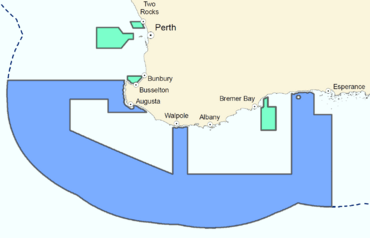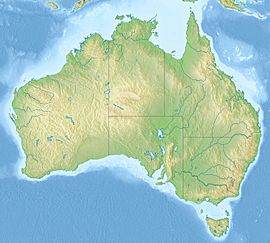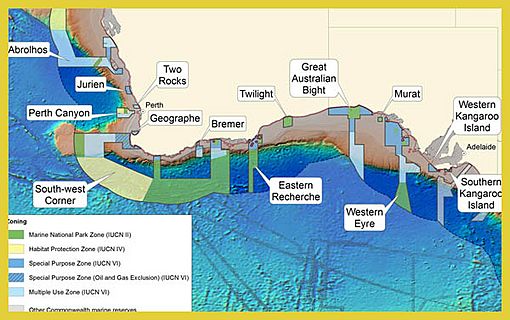South-west Corner Marine Park facts for kids
Quick facts for kids South-west Corner Marine ParkAustralia |
|
|---|---|

The South-west Corner Marine Park, highlighted in blue, south of Western Australia's lower south west and southern coast
|
|
| Established | 14 December 2013 |
| Area | 271,833 km2 (104,955.3 sq mi) |
| Managing authorities | Director of National Parks |
| Website | South-west Corner Marine Park |
The South-west Corner Marine Park is a special ocean area in Western Australia. It's like a national park, but underwater! This park helps protect the amazing plants and animals that live in the ocean.
It's located off the lower south-west and southern coast of Western Australia. This park is one of 14 important ocean parks in the South-west Marine Parks Network. The park was officially created on December 14, 2013. It got its current name on October 11, 2017.
Contents
What Makes This Park Special?
The South-west Corner Marine Park has many unique features. These are like special landmarks or areas that are important for the ocean environment.
Underwater Features
- Albany Canyon: A huge underwater valley.
- Cape Mentelle upwelling: An area where cool, nutrient-rich water rises from the deep. This brings food for many creatures.
- Diamantina Fracture Zone: A very deep crack in the ocean floor.
- Naturaliste Plateau: A large, flat area under the sea.
- Donnelly Banks: Underwater hills or mounds.
This marine park is in "Commonwealth waters." This means it's managed by the Australian government. It's further out from the coast than state parks, like the Ngari Capes Marine Park, which are managed by Western Australia.
Why Is This Park Important?
The South-west Corner Marine Park protects many important things. It's a safe home for many different kinds of marine life.
Protecting Marine Animals
This park is a vital area for many animals, including:
- Whales: It's a key place for humpback whales and blue whales as they travel.
- Sharks and Sea Lions: It's an important feeding area for the amazing white shark and the Australian sea lion.
- Birds: Birds like the Indian yellow-nosed albatross and soft-plumaged petrel find food here.
- Other Whales: Sperm whales also use this area for feeding.
- Sea Birds: Birds like the flesh-footed shearwater, short-tailed shearwater, and Caspian tern visit this park.
- Southern Right Whales: This park is a seasonal place where southern right whales have their babies.
Unique Ocean Areas
The park also protects different ocean environments, called "bioregions." These are like different neighborhoods in the ocean, each with its own types of plants and animals. The park covers parts of three provincial bioregions and two meso-scale bioregions.
Special Underwater Places
The park includes six very important underwater features:
- Albany Canyon Group: This area is very productive, meaning lots of food is available. Many animals gather here to feed.
- Cape Mentelle Upwelling: This spot also has high productivity. The rising water brings nutrients, supporting a rich food web.
- Diamantina Fracture Zone: This deep-sea feature is unique. It likely has special deepwater communities with many different species, some found nowhere else.
- Naturaliste Plateau: Like the fracture zone, this plateau is a unique underwater feature. It probably supports diverse deepwater communities with species found only there.
- Western Rock Lobster Habitat: This area is home to the western rock lobster. These lobsters play an important role in the ocean's ecosystem.
- Recherche Archipelago Environment: The waters around the Recherche Archipelago have high biodiversity. Many animals gather here for breeding and resting. It also has the largest areas of reef on the continental shelf in this region.
Donnelly Banks
The Donnelly Banks, located east of Augusta, are another important part of the park. They are known for being very productive and provide important nursery habitats for young marine animals.



